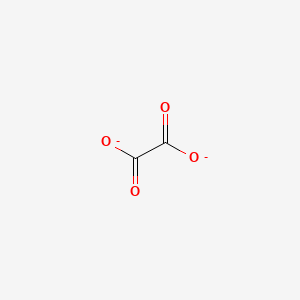Ferroptosis-centered Drug Response Information
General Information of the Drug (ID: ferrodrug0279)
| Name |
Oxalate
|
||||
|---|---|---|---|---|---|
| Synonyms |
oxalate; Oxalate Ion; ethanedioate; oxalate(2-); Oxalic acid, ion(2-); Ethanedioic acid, ion(2-); 338-70-5; PQ7QG47K6T; oxalate2-; oxalate dianion; 3mof; 2rk7; OXL; OXALATE ION(2-); UNII-PQ7QG47K6T; OXALATE (C2O42-); GTPL4538; BDBM92964; CHEBI:30623; OXALATE ION (C2O42-); MUBZPKHOEPUJKR-UHFFFAOYSA-L; DTXSID901047254; A808245; Q27088221
Click to Show/Hide
|
||||
| Status |
Investigative
|
||||
| Drug Type |
Small molecular drug
|
||||
| Structure |
 |
||||
| Formula |
C2O4-2
|
||||
| IUPAC Name |
oxalate
|
||||
| Canonical SMILES |
C(=O)(C(=O)[O-])[O-]
|
||||
| InChI |
InChI=1S/C2H2O4/c3-1(4)2(5)6/h(H,3,4)(H,5,6)/p-2
|
||||
| InChIKey |
MUBZPKHOEPUJKR-UHFFFAOYSA-L
|
||||
| PubChem CID | |||||
| TTD Drug ID | |||||
Full List of Ferroptosis Target Related to This Drug
Nuclear receptor coactivator 4 (NCOA4)
| In total 1 item(s) under this Target | |||||
| Experiment 1 Reporting the Ferroptosis-centered Drug Act on This Target | [1] | ||||
| Target for Ferroptosis | Driver | ||||
| Responsed Disease | Kidney calculus | ICD-11: GB70 | |||
| Pathway Response | Fatty acid metabolism | hsa01212 | |||
| Ferroptosis | hsa04216 | ||||
| Autophagy | hsa04140 | ||||
| Cell Process | Cell ferroptosis | ||||
| Cell autophagy | |||||
| In Vitro Model | HK-2 cells | Normal | Homo sapiens | CVCL_0302 | |
| In Vivo Model |
Five-week-old male SD (Sprague-Dawley) rats (130-180 g) were used as experimental subjects. The control group had a normal diet, and the stone model group drank water containing 0.75% ethylene glycol. After feeding for one month, rats were sacrificed, and their kidneys were removed and subjected to silver nitrate staining, immunohistochemistry, and western blotting on the specimens of the normal control group and the kidney stone model group to explore the expression of NCOA4 in kidney stone model rats.
Click to Show/Hide
|
||||
| Response regulation | Oxalate activates autophagy to induce ferroptosis of renal tubular epithelial cells and participates in the formation of kidney stones. Moreover, after oxalate treatment, overexpression of the BENC1 gene increased cell oxidative damage and ferroptosis. In addition, knockdown of NCOA4 reversed the effect of oxalate-induced ferroptosis in HK-2 cells. | ||||
